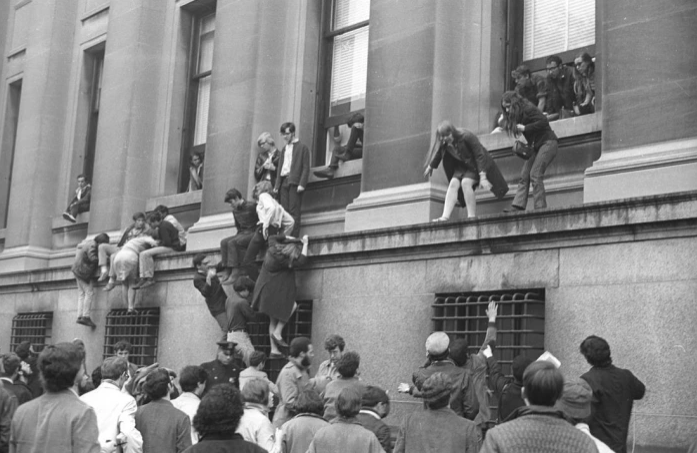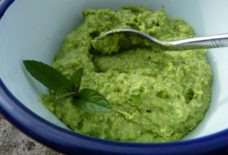Columbia Student Protest History: Free Speech in a Land Owned by Law and Order
By: María Teresa Fidalgo-Azize | Arab America Contributing Writer
Everyone who thinks back on those times will recall that a variety of thoughts and feelings, some of them fairly vague, without immediate connection to any mood. Among a good many students, not just the radicals, there was a suspicion that American society as a whole had taken a wrong turn —a worried suspicion that impersonal institutions had lost contact with ordinary humanity and with moral behavior, and the whole of society had begun to lose its human quality.
Paul Berman, Foreword to A Time to Stir: Columbia’s’68
Can justified outraged be successfully moderated out of fear of punishment? The principle of civility and its correlation with non-violent manifestation walk alongside the hegemony bastion of American democracy known as law and order- preservation of the status quo. To remain calm, collected, immune to the surges of passion and indignation amidst the ongoing genocide in Gaza against the Palestinian people is antithetical to the human condition’s empathy towards suffering despite the effort of institutional power to demand a politicized neutrality- an inoculation of numbness. Mass mobilization be it encampments, peaceful protests, and pursuits for dialogue thread the essence of the United States’ First Amendment: free speech. Be it uncomfortable. Be it confrontational. Be it even offensive. To leash collective or individual expression is to harness the idea of what is the United States beyond the preconditions of law and order.
Columbia University’s students have been at the forefront of the student activism movement against the war in Gaza demanding the university to divest its economic ties with Israel. To question the legality of these claims and their implications, besides the probability of their realization merits revision, specifically as Dr. Steven Mintz in the interview History of Campus Protest of 1964 till now mentioned regarding the faltering structural organization and leadership of the movement. Nevertheless, the crass demonization of these students led by media institutions misleads the general public on the essence and nature of the meaning of the Free Palestine chant.
To understand or better yet to attempt to contextualize 2024’s student activism within Columbia’s student protest history, it is paramount to look at the paradigmatic year of 1968— a communal cry against war and segregation.
Empathy and the Firing Shot of Activism

The society in which we were raised was rooted in the violence of impending nuclear war and of assassinations and carpet bombings, the violence stemming from poor educational opportunities and from a lack of decent housing and jobs, and the violence of inequality. There is a collective responsibility that any society must bear. The sixties were a reaction to the world that we inherited. The cynicism and rage of our generation was spawned from the society in which we lived.
Susan Kahn, The Moral Obligation to Act
Children of the social justice ethos of the Vietnam anti-war age and civil rights activism, Columbia students became aware of the university’s relationship to the IDA (Institute for Defense Analyses) and the construction of a segregated gymnasium in Morningside Park, near West Harlem also known as the ‘Gym Crow’ controversy which would displace African-American and Puerto Rican people from their residency for the construction of the “ community center” gym. Due to the intersecting correlation of injustices, both the SAS (Student Afro-Society) and SDS (Students for a Democratic Society) began manifesting their dissent of Columbia University’s institutional bureaucracy and political ties on campus.
The first protest occurred in March 1968 eight days before the assassination of Martin Luther King. As the momentum of indignation arose, students began protest that spread to Morningside Park, at the specific construction site of the gymnasium. Followed by NYPD arrests of students, the defining event of student mobilization at Columbia University occurred: Columbia students took over Hamilton Hall, a student housing compartment and the offices of Columbia College administration. Despite race divisions between Black and white students over the main objective of the protest and of who would occupy the buildings on the Columbia campus, the protesters were suppressed by the state apparatus and 700 people were arrested by NYPD.
In spite of the state and institution’s violent and rash response to the emboldened students, Columbia University abandoned plans for the construction of the Morningside Park gymnasium in 1969 and disaffiliated from the IDA.
Conclusion
Honest conversations and manifestations on the subject of institutional violence such as the genocide in Gaza unfortunately are embedded in today’s attention and outrage economy. The organization for peaceful protest and encampments boycotting financial ties with Israel in Columbia University follows a lineage of both free speech and social-awareness resistant to collective numbness and apathy. Accusations of antisemitism warrant discussion. However, unilateral defamation cataloguing protesters as agitators and rioters which require police intervention mocks not only participatory democracy but demonstrates how for some, being uncomfortable/challenged is misunderstood as an attack or a threat. Hence, violence- the utter removal of humanity- is now just a nuisance- anything characterized as disagreeable such as a complaint. The history of Columbia’s 1968 student protests serve as the ancestral tree for today’s mass mobilization against injustice — one skeptical of polite indignity and unmoved by non-structural claims to change.
Works Cited
Bingham, Clara. “‘The Whole World Is Watching’: An Oral History of the 1968 Columbia Uprising.” Vanity Fair, 26 Mar. 2018, www.vanityfair.com/news/2018/03/the-students-behind-the-1968-columbia-uprising.
Cronin, Paul, editor. A Time to Stir ’68. Columbia University Press, 2018.
Tong, Scott, host. “ History of campus protest of 1964 to now”. Here and Now. wburg.org. May 6th 2024. https://www.wbur.org/hereandnow/2024/05/06/campus-protests-history
Check out Arab America’s blog here!








